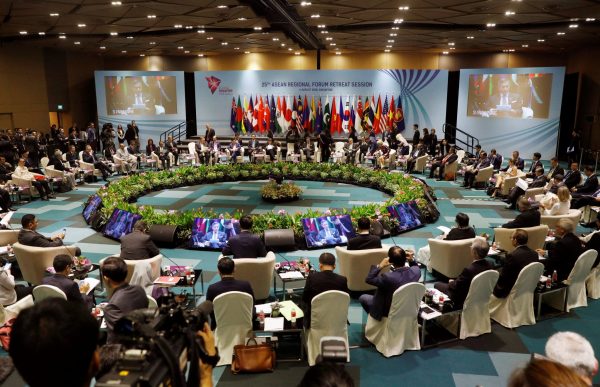In the midst of tumultuous geopolitical changes taking place around the world, ASEAN continues to be the bulwark that holds the Southeast Asian region together. ASEAN centrality and unity remains key to the grouping’s ongoing quest to build a resilient and innovative Southeast Asia and to improve its relations with external partners.
The South China Sea disputes remain the litmus test of ASEAN centrality and unity given the potential for the disputes to divide the group. At the start of the ASEAN–China Post Ministerial Conference, Singapore’s Minister of Foreign Affairs Vivian Balakrishnan announced that the foreign ministers from ASEAN member states and China had agreed on a draft document that will form the foundation of negotiations for a South China Sea code of conduct (COC). He described it as ‘yet another milestone in the COC process’.
Even so, Balakrishnan sought to manage expectations and cautioned that COC negotiations are far from over. The competing territorial claims in the South China Sea have not been resolved, he reminded, as the COC ‘was never meant to resolve territorial disputes’.
Another major threat to ASEAN centrality is the rapidly shifting geopolitical landscape in the region with the intensification of major power politics. US–China trade frictions continue to spiral, with no end in sight.
US Secretary of State Mike Pompeo sought to give assurances of sustained US interest in the region during his visit to Southeast Asia for the AMM and related meetings. This included announcing the US$113 million that the US government has earmarked for new technology, energy and infrastructure initiatives in Asia, as well as another US$300 million ‘to reinforce security cooperation throughout the entire [Indo–Pacific] region’.
But despite Pompeo’s assurances, US commitment to upholding the current regional order remains in doubt, especially given US President Donald Trump’s protectionist streak and tendency to question the utility of US alliances.
Internally, ASEAN also has its share of troubles. The South China Sea disputes and the issue of the Rakhine State in Myanmar — with ASEAN’s apparent lack of unity in the former and reported inability to address the latter — are raising doubts about ASEAN’s ability to address tough issues.
But not all is lost. As the positive development on the South China Sea disputes at the AMM and related meetings in Singapore demonstrates, ASEAN is still well in the game — even if obstacles remain.
ASEAN’s role as the anchor of the region will become even more important in the future. With the possibility of US retrenchment from the region and China’s growing influence, ASEAN will need to ensure it is steadfast in ensuring its centrality in the region.
The South China Sea will continue to assume significance in ASEAN. In spite of claims that ASEAN has a limited role in the South China Sea disputes (given that only four of its members are actual claimants), ASEAN will need to step up to ensure its collective interests are respected and to ensure that these disputes do not escalate into full-blown conflict.
The AMM and related meetings have been and continue to be an important avenue to address this issue — though not without its hiccups, particularly in 2012 when no joint communique was issued due to disagreements over the South China Sea. But since then the disputes have once again featured in the joint communiques, with the latest highlighting the draft COC negotiating text.
Despite the issuance of the draft text, it remains unknown when the COC will materialise, especially because the mutually agreed timeline on negotiations has not been made public. Land reclamations and the militarisation of disputed features in the South China Sea continue and ASEAN will need to address this issue sooner rather than later — possibly a tall order given the desire of most ASEAN claimant states to maintain good relations with China.
But these remaining uncertainties are all the more reason why ASEAN needs to continue to work assiduously to manage the South China Sea disputes and contain any rising tensions. Without ASEAN’s efforts, major powers would likely have a much easier time dividing the region over matters such as the South China Sea.
The success of the 51st AMM and related meetings in Singapore reflects the crucial role that ASEAN plays in Southeast Asia and beyond. Moving forward, ASEAN must continue to be proactive about ensuring that it maintains its centrality and that external countries see value in ASEAN taking the driver’s seat.
Henrick Z Tsjeng and Shawn Ho are Associate Research Fellows with the Regional Security Architecture Programme at the Institute of Defence and Strategic Studies, S Rajaratnam School of International Studies (RSIS), Nanyang Technological University, Singapore.
A version of this article originally appeared here on RSIS.

